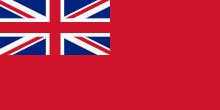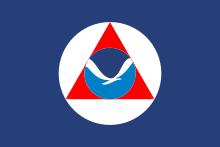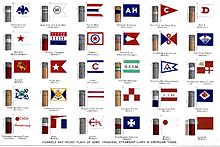- Maritime flag
-
 A medieval ship flag captured by forces from Lübeck in the 1420s showed the arms of Denmark, Sweden, Norway and Pomerania. The original flag was destroyed during a World War II attack on the city, but a 19th century copy remains in Frederiksborg Palace, Denmark. The saint accompanying the Virgin Mary and infant Christ is Saint James the Greater, identified by his scallop shell emblem.
A medieval ship flag captured by forces from Lübeck in the 1420s showed the arms of Denmark, Sweden, Norway and Pomerania. The original flag was destroyed during a World War II attack on the city, but a 19th century copy remains in Frederiksborg Palace, Denmark. The saint accompanying the Virgin Mary and infant Christ is Saint James the Greater, identified by his scallop shell emblem.
A maritime flag is a flag designated for use on ships, boats, and other watercraft. Naval flags are considered important at sea and the rules and regulations for the flying of flags are strictly enforced. The flag flown is related to the country of registration: so much so that the word "flag" is often used symbolically as a synonym for "country of registration".
Contents
Types of flags
Ensigns
Main article: EnsignEnsigns are usually required to be flown when entering and leaving harbour, when sailing through foreign waters, and when the ship is signalled to do so by a warship. Warships usually fly their ensigns between the morning colours ceremony and sunset when moored or at anchor, at all times when underway, and at all times when engaged in battle—the "battle ensign". When engaged in battle a warship often flies multiple battle ensigns. This tradition dates from the era of sailing vessels. Tradition dictated that if a ship lowered its ensign it was deemed to have surrendered. Masts were targets of gunfire, and the second and subsequent ensigns were flown in order to keep the ensign flying even after a mast hit.
Jacks
 Chilean Navy Jack
Chilean Navy Jack
- See also:
 Media related to Naval jacks at Wikimedia Commons
Media related to Naval jacks at Wikimedia Commons
Jacks are additional national flags flown by warships (and certain other vessels) at the head of the ship. These are usually flown while not under way and when the ship is dressed on special occasions. Jacks in the Royal Navy must be run up when the first line is ashore when coming alongside.
In Britain's Royal Navy, the Union Flag at sea serves both as a naval jack and as the rank flag of an Admiral of the Fleet. It is illegal for a merchant ship or yacht to fly the Union Flag, but permissible to fly a civilian jack (sometimes known as the pilot jack as it was formerly used to request a pilot) that consists of the Union Flag with a white border. The St George's Cross flown from the jackstaff is known as the Dunkirk jack, and is customarily flown by ships and boats which took part in the Dunkirk evacuation operation in 1940. The flying of the St George's Cross elsewhere on a civilian ship is illegal, as it is the rank flag of a full Admiral.
Distinguishing marks
On 16 January 1899, commissioned ships of the United States Coast and Geodetic Survey were authorized to fly their own flag to distinguish them from ships of the United States Navy, with which they shared a common ensign. Although they continued to fly the same ensign as U.S. Navy ships, ships of the Survey flew the Coast and Geodetic Survey flag as "distinguishing mark" until the newly created National Oceanic and Atmospheric Administration took over control of the Survey's ships in 1970. Since then, commissioned ships of NOAA, which also fly the same national ensign as Navy ships, have flown the flag of the National Oceanic and Atmospheric Administration as a distinguishing mark.
Rank flags
 Rank flag of a Rear Admiral of the Indian Navy.
Rank flag of a Rear Admiral of the Indian Navy.
The rank flag or distinguishing flag is the flag flown by a superior officer on his flagship or headquarters (hence the term flagship). The origins of this are from the era before radiotelegraphy and radiotelephony, when orders were given by flag signals. The flag denotes the ship which must be watched for signals designating orders. Such flags are also flown when leaders of the government (presidents, prime ministers or defense secretaries) are aboard Navy ships, showing the ship to hold the headquarters of highest level of authority for the Armed Forces. Today, with the progress in communications, this flag indicates the obligation of the other Naval vessels to pay the relevant honours (Manning the rails, firing cannon salute, attention, etc.) according to nautical etiquette. In a group of naval ships all commanded by superior officers, only the commander of the group or the officer of the highest rank can fly his flag.
- In the Royal Navy, admirals fly rectangular rank flags: an Admiral of the Fleet flies a Union Flag, while an admiral flies the St George's Cross. The flags of vice-admirals and rear-admirals have one and two additional red balls respectively. Commodores fly a Broad Pennant which is a short swallow-tailed pennant based on the St George's Cross, with a red ball at the canton (upper quarter next to the staff).
- In the United States Navy as well as in some other countries, admirals fly rectangular flags with stars according to rank. Line officer flags are blue with white stars, while staff officer flags are white with blue stars.
- In the Hellenic Navy (Greek Navy) Admirals fly blue square flags bearing a white cross (similar to the Hellenic Navy Jack) with four six-point stars (one in each of the squares formed by the cross); Vice-Admirals fly the same flag but with three stars; Rear Admirals two stars; and Commodores one star. Captains, when commanding a flotilla or squadron, fly a burgee (square swallow-tailed flag) with the colours of Hellenic Navy Jack. When a rank flag is flown the commissioning pennant is displaced downward.
Pennants
The pennant, historically called a pennon, is a long narrow flag, conveying different meanings depending on its design and use. Examples:
- A commissioning pennant, or masthead, which a warship flies from its masthead and indicates the commission of the captain of the ship (and thus of the ship itself). In the Royal Navy, the commissioning pennant is a small St George's Cross with a long tapering plain white fly. In the United States Navy, it is red above white, with seven white stars in the blue hoist. The commissioning pennant may be displaced by various rank flags, namely the flags or pennants of admirals or commodores, and the personal flags of heads of state and members of royal families. In former centuries, masthead pennants were of a length similar to that of the ships that wore them, but nowadays very long pennants tend only to be seen when a ship is paying off.
- A church pennant, as used by the Royal Navy, European Navies and Commonwealth Navies, is a broad pennant flown on ships and at establishments (bases) during religious services, and has the George Cross and Dutch flag incorporated; chosen after the English Dutch Wars where both sides stopped for Church on a Sunday.
- A Senior Officer Present Afloat pennant using the NATO signal flag for "Starboard" is green on the hoist and fly with a white field between.
- A Gin Pennant means that the wardroom is inviting officers from ships in company to drinks. The origins of the Gin Pennant are uncertain, but it seems to have been used since the 1940s and probably earlier. Originally it was a small green triangular pennant measuring approximately 18 by 9 inches (460 by 230 mm), defaced with a white wine glass, nowadays the gin pennant is a Starboard pennant defaced with a wine or cocktail glass. Its colour, size and position when hoisted were all significant as the aim was for the pennant to be as inconspicuous as possible, thereby having fewer ships sight it and subsequently accept the invitation for drinks. The Gin Pennant is still in regular use by Commonwealth Navies, such as the Royal Australian Navy (RAN). Within the RAN it is common practice, whilst in port, for junior officers of one ship to attempt to raise the Gin Pennant on the halyard of another ship, thereby forcing that ship to put on free drinks for the officers of the ship that managed to raise the pennant. If, however the junior officers are caught raising the pennant, then it is their ship that must put on free drinks within their Wardroom. Usually this practice is restricted to Commonwealth Navies; however, prior to increased force protection, RAN officers have successfully raised the Gin Pennant on a number of units in the USN.[citation needed]
House flag
Merchant ships often fly a flag identifying which company owns the vessel. This was formerly flown from the mainmast but is now usually flown from a short mast at the bow.
Yacht club burgee
Main article: BurgeeMembers belonging to a yacht club or sailing organization may fly their club's unique burgee both while underway and at anchor (however, not while racing). Sailing vessels may fly the burgee from the main masthead or from a lanyard under the starboard spreader on the mast.[1] Power boats fly the burgee off a short staff on the bow.
Traditionally, the first time a member of one club visits another, there is an exchange of burgees. Exchanged burgees are then often displayed on the premises of each, such as in a club office or bar.
Unit citations
Warships of various navies may be awarded a unit citation, for which a burgee (tapering flag with swallow-tail fly) is flown when in port.
- Ships of the United States Navy:
- Presidential Unit Citation - yellow with blue stripe on top and red stripe at the bottom.
- Navy Meritorious Unit Commendation - green with four yellow stripes divided by two blue and one red stripes at the centre.
- Navy Unit Commendation - symmetrical colouring from the centre: green, red, yellow, blue.
- Ships of the Royal Australian Navy may have:
- Unit Citation for Gallantry - burgee with narrow white band surrounding green field surmounted by a silver star.
- Meritorious Unit Citation - design as above with yellow field.
Signal flags
Main article: International maritime signal flagsThere is a system of International maritime signal flags for each numeral and letter of the alphabet. Each flag or pennant has an additional meaning when flown individually.
Courtesy flag
A courtesy flag (or courtesy ensign) is flown by a ship in foreign waters as a token of respect by a visiting vessel. It is often a small (that is, smaller than the ship's own national ensign) national maritime flag of the host country, although there are countries (such as Malta) where the national, rather than the maritime flag is correct. The flag is customarily worn at the foremasthead of multi-masted vessels, the starboard yardarm or crosstree of the mast of single-masted vessels, and from the jackstaff of vessels without masts.
Flag etiquette
The position of honour on a ship is the quarterdeck at the stern of the ship, and thus ensigns are traditionally flown either from an ensign staff at the ship's stern, or from a gaff rigged over the stern.
The usual rule that no flag should be flown higher than the national flag does not apply on board a ship: a flag flown at the stern is always in a superior position to a flag flown elsewhere on the ship, even if the latter is higher up.
The priority of hoisting locations depends on the rig of the vessel. With sloops, ketches and schooners the starboard yardarm or spreader of the highest or main mast is the second most honoured position. (That is, after the ensign at the stern.) Next after the starboard spreader is the port spreader. House flags (those defining the owner) are usually flown from the mainmast truck. When a club burgee is flown, it will normally be hoisted to the truck of the most forward mast. On a sloop, then, not having a foremast, the house flag could be moved to the port spreader if the starboard spreader was in use, and a burgee was being flown. On a ketch, the house flag would be moved to the mizzen.
When in port, the ensign should always be flown from the staff at the stern. This is traditional, because in former times the gaff was then lowered along with the mizzen sail. The only ensign ever flown from the starboard spreader or yardarm is that of a nation being visited. This is known as a courtesy hoisting of a Courtesy Flag.
At sea, it used to be that the ensign was flown from the mizzen gaff. When Bermudian sails came into general use, some skippers started to fly the ensign from 2/3 the way up the main-sail leech. Many consider this an affectation with the past. Others have taken to flying the ensign from a backstay. These are not good locations because the flag does not fly out well when hoisted raked forward.
The Canadian Heritage web page states:
“ whenever possible, the proper place for a vessel to display the national colours is at the stern, except that when at sea, the flag may be flown from a gaff; when in harbour the flag should be hoisted at 0800 hours and lowered at sunset. ” Another recent custom has been to fly a burgee and/or a cruising or power squadron flag from the starboard spreader. This custom has arisen because many sailboats today place a racing flag or wind indicator at the masthead.
Motor boats without masts should always fly the ensign from an ensign staff at the stern. Conventionally, courtesy flags are flown from a staff at the bow. This seems to some landsmen as being a reversal of priorities. However, a boat is steered by the stern and this gives it pride of place.
Nautical etiquette requires that merchant vessels dip their ensigns in salute to passing warships, which acknowledge the salute by dipping their ensigns in return. Contrary to popular belief the United States Navy does dip the Stars and Stripes in acknowledgement of salutes rendered to it. Merchant vessels traditionally fly the ensign of the nation in whose territorial waters they are sailing at the starboard yard-arm. This is known as a courtesy flag, as for yachts.
The flying of two ensigns of two different countries, one above the other, on the same staff is a sign that the vessel concerned has been captured or has surrendered during wartime. The ensign flying in the inferior, or lower, position is that of the country the ship has been captured from: conversely, the ensign flying in the superior, or upper position, is that of the country that has captured the ship.
 HMY Britannia (with Rear Admiral aboard) dressed overall on the River Mersey, Liverpool.
HMY Britannia (with Rear Admiral aboard) dressed overall on the River Mersey, Liverpool.
Dressing overall
As a sign of celebration, ships in harbour may be 'dressed overall' by stringing International Code flags (arranged at random) from stemhead to masthead, from masthead to masthead (if the vessel has more than one mast) and then down to the taffrail. When a ship is properly dressed, ensigns (in addition to the one flown in the usual position at the stern) should fly at each masthead, unless displaced by another flag - e.g. that of a flag officer. Ships may be dressed for occasions, anniversaries and events, whether national, local or personal. A ship underway would not array herself with signal flags, but the masthead ensign(s) would still signify that she is dressed.[2]
See also
- Flag
- Flag state
- Flag of convenience
- Flag terminology
- Vexillology - the study of flags
- Civil ensign
- Naval ensign
- British ensigns
- Broad pennant
- Jolly Roger - the pirate flag
- Gallery of maritime flags
- Ship registration
References
- ^ Rousmaniere, John (1999). The Annapolis Book of Seamanship (3rd ed.). New York: Simon & Schuster. p. 370. ISBN 978-0-684-85420-5. http://books.google.com/books?id=xRqzoX04v5AC&pg=PA370. Retrieved June 30, 2011.
- ^ 'Flags and Signals' by Cdr R.L. Hewitt, Royal Yachting Association 1969, 1984
External links
- Rules of Flag Usage in the Merchant Marine USA Merchant Marine only.
- All About Flags - A simple guide to marine flags and basic flag etiquette
- Flag Advisor - Flag etiquette and recommendations
- TheCrusingLife.com's Flag etiquette
- Seagate Yacht Club's exchanged burgee collection
- Crystal Lake Yacht Club's Burgree collection
- Nautical Flags Alphabet
Categories:- Ensigns
- Flags
- Water transport
- Vexillology
- Maritime culture
- Navy flags
- See also:
Wikimedia Foundation. 2010.







